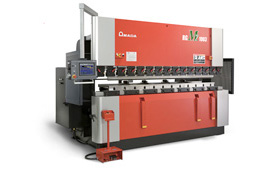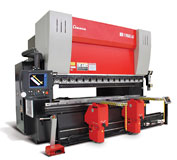Brake Presses operate with the basic mechanic of bringing together and Upper and Lower Beam holding a Punch and Die respectively bending the sheet metal between them. Brake presses which have a stationary lower beam are referred to as Down Acting Brakes because the powered beam moves downwards. Respectively Brake Presses which have a fixed upper beam and a powered lower beam are Up Acting Brakes. Each style has its own distinct advantages and disadvantages.
Up Acting Brakes

Pros:
- Because the ram sits on the cam instead of hanging on it, as the bearings and cam wear down the motion of the ram stays consistent. There is no free movement as it transitions from the up stroke to the down stroke.
- Because the operator has to move with the ram it requires that they are more conscious of their actions, possibly reducing the risk of injury.
- Because the beam moves upward under power if there is a mechanical failure the lower beam will fall away.
Cons:
- Less common than down acting brakes, therefore there may be a learning curve for operators.
- It may be harder to keep the piece set against the back gauge when moving with the part.
- More operator movement is involved possibly affecting the ergonomics of the work.
Down Acting Brakes
Pros:
- Easy for the operator to hold the work piece against the back gauge while bending, improving accuracy.
- More ergonomic for the operator because they don’t need to move with the piece, makes it easier to support the piece as its being bent.
Cons:
- Since the ram hangs on the cam instead of sitting on it, as the bearings and cam wear down the motion and tonnage of the ram may vary when bending affecting quality. This also means there can be some free motion between the up stroke and down stroke.
- On old mechanical brakes, and even under some circumstances the new hydraulic brakes, a mechanical failure can allow the upper beam to fall and possibly injure the operator.